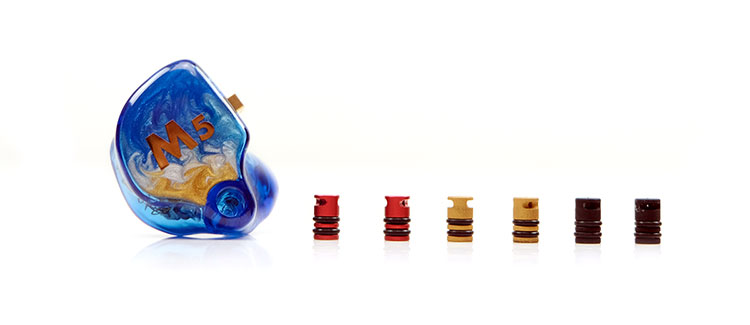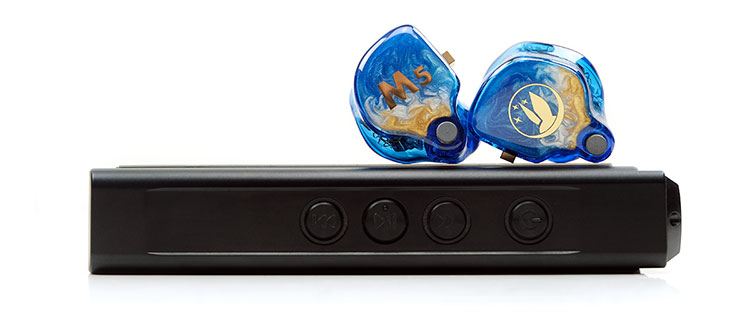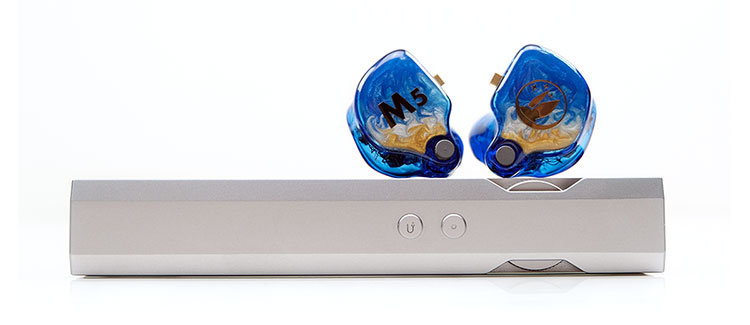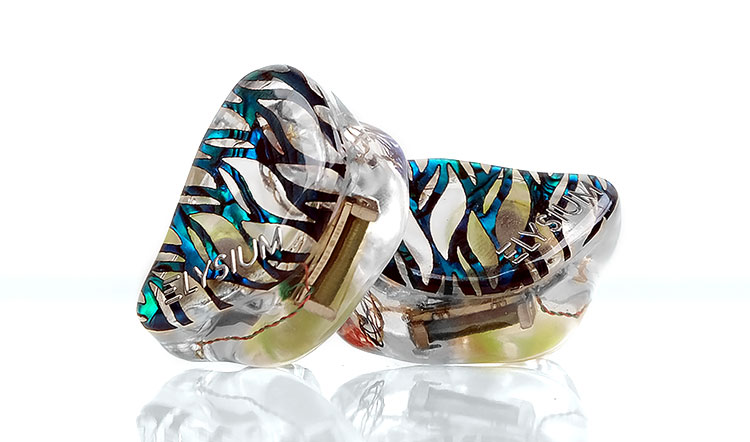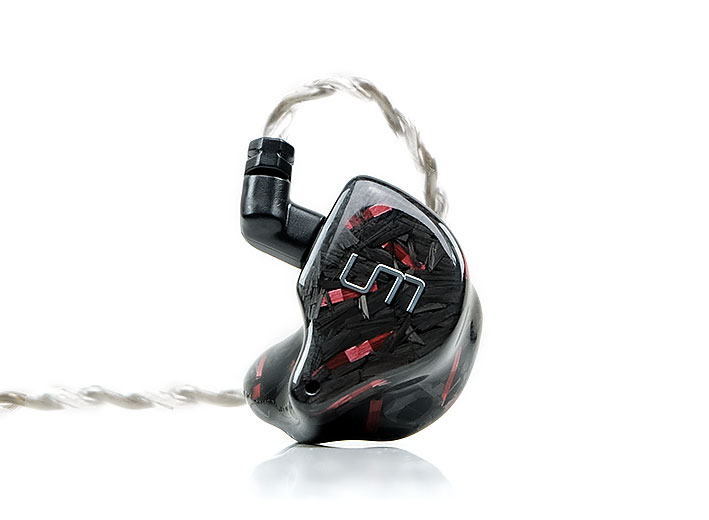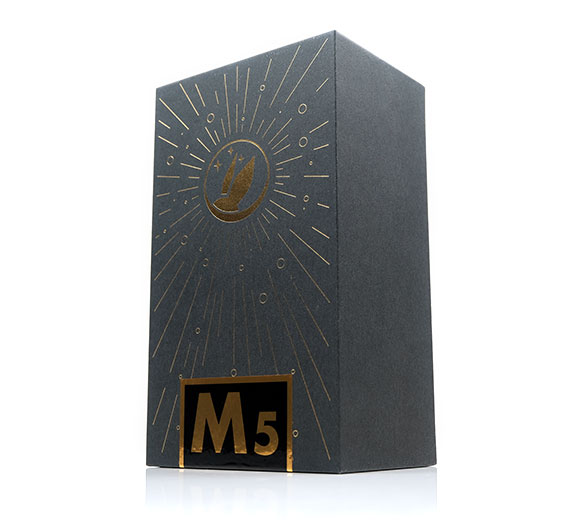Sound Impressions
Summary
The M5 is not one but 4 distinct sound signatures depending on which ATOM filter you decide to use. FiR Audio has loosely defined them in terms of bass perception with the Yellow ATOM filter offering the most and the red ATOM filter offering the least. The stock, and for me the most balanced of the four, is the silver ATOM so it’s worth starting there.
The overall presentation here veers more to the musical and smooth side than a neutral or reference tuning with the star of the show the low-end and to a slightly lesser extent the vocal performances. Treble is lively but controllable with more of an upper mids and lower treble emphasis than upper treble sparkle.
Dynamic Driver Texture
The dynamic driver is full, weighty, and extends marvelously to produce a nice balance of power and warmth. Unlike the Odin, for example, there is less of a pure sub-bass emphasis and more mid-bass warmth with less of a drop into the lower-mids.
It does not quite have that absolute extension like the Odin but it does sound fuller from 100-300Hz as a result low-end instrumental pitching comes forward a bit more and sounds nicely fleshed out. Here you really want a source to maximize that because the texture and detail from the M5 low-end are simply gorgeous when optimally driven. DAP’s like the R2R LP 6 will do that perfectly.
Vocal Performances
Vocals range from slightly north of neutral to further forward with more contrast depending on where they pitch. The M5 does have a relatively strong bump from 2-5k, in part to balance out the weighty bass response, in part to give the vocals some gravitas. The higher the pitch the further forward vocals will sound on the M5.
BA texture does take precedent here so it is not quite as textured or liquid sounding but it makes up for that with some nice articulation and a good harmonic balance, especially with smooth-sounding sources.
There is a shade more treble contrast compared to male vocals which pull more from the mid-bass and upper bass warmth but nothing significantly sibilant, simply cleaner sounding, especially for percussion.
Treble Extension
FiR Audio has resisted going ballistic on the mid of BA and EST drivers which in turn keeps the M5 mids timbre more to the smooth and sweet side than precise and clinical which I always favor for BA drivers.
Yes, it is slightly to the drier side but neither is it too hot or peaky. The emphasis is more on delivery energy from around 2k to around 7k and giving those mids and lower treble more prominence to balance out the bass density and forwardness.
Beyond that, there is a bit of fade so the M5 does not the most extended of top-ends and in turn this ups the perception of a bit of intimacy in those forward mids. It also means that the percussion energy does not come hand in hand with any splashiness that overpowers the vocal performances.
I had mentioned before the M5 has a deceptively good harmonic balance. That becomes more noticeable when you compare it to something like the UM MEST which delivers a bit of a sting in its lower treble and vocal attacks that can upset its otherwise excellent tonal balance.
Staging
The M5 offers excellent but not gut-wrenching depth with a blended sub-to-mid bass tuning that ups the forwardness and body rather than outright rumble.
There is not a huge dip in the lower-mids either so the warmth and presence travel upwards with lower-mids instruments offering some nice fullness and not sounding terribly recessed or lacking in body. You could argue a natural to intimate staging quality with an even-harmonic emphasis and better fullness than some competing monitors.
Upper mids are further forward though in its staging with some nice 2-4k emphasis and a peak around 5-7k. Vocals have some relative clarity and never overwhelmed by the bass response.
Air is at a premium though so the staging quality is stretched just enough in terms of instrumental placement and the imaging is not cast that far and wide. This is more of a natural dance hall sized stage presentation with accurate placement than a grandiose arena quality. However, it is probably the M5’s strongest staging characteristic as it does it so well.
Much of that is due to the fade on the upper treble which draws the listener’s focus more on the M5’s stronger upper mids and lower treble presence which in turn closes in the stage slightly.
Red ATOM
The red ATOM has the lightest perceived bass response, officially rated at -4dB which is not a huge such out, to be honest, but it is noticeable. You still get a nice bass punch and some mid-bass warmth but not that wall of power and body from the silver stock module.
In turn, you get a diminished sense of depth, midrange timbre is lighter and sweet-sounding, not as rich or dense as the silver ATOM but vocals do come even more to the fore, especially male vocals. The staging quality has more of a width and height bias this time around and you do become more aware of some quality mids left/right imaging.
Black ATOM
The black ATOM filter reduces the bass response from the silver by -2dB. If you are switching from red to black you will notice that primarily in the mid-bass to sub-bass bias. It sounds a little juicer, especially in the lower-mids with some ‘phat’ bass guitar plucks and bass synth offering more body than the red and better presence.
It is still not as in your face as the yellow and silver ATOM filters so mids still have some nice prominence with vocals shining very nicely. What it does is tease out a bit more depth and power which helps with staging complexity quite nicely. To be honest, this, combined with the silver are my go-to filters for male vocals and middle-of-the-road rock numbers.
Yellow ATOM
The yellow or gold ATOM will up the bass response the most with a 6dB swing from the lightest red ATOM. The low-end becomes much more powerful and dense sounding right up to the lower-mids but then the mids themselves take a small knock in presence compared to the other filters.
Understandable considering how much more bass presence there is but it does seem the lower-treble gets a small lift also accentuating both ends of the spectrum creating a taller and deeper sound stage as well as adding a little more spice in the mids timbre. It is not as relaxing as the black or even the stock silver but more satisfying for those who like EDM or harder hitting music.
Synergy
Efficiency
The M5 is rated at 6.8Ω but without an official SPL rating. In our comparisons below, we did some simple A/B testing using the Lotoo PAW Gold Touch balanced output (same rating as its single-ended output) in low-gain to get a feel for the overall sensitivity of the M5.
What was found overall was an estimated 110dB SPL rating or no higher than 112dB. We compared the Empire Ears Odin rated at 108dB, the UM MEST rated at 118dB, and the VE Elysium which is the lowest at 105dB. The M5 did need more current compared to the Elysium, it was more marginal compared to the Odin but still slightly higher and was less sensitive than the MEST.
In summary, it is not that hard to drive but volume demands are a little higher than your usual high sensitivity offerings such as the Andromeda 2020 or even the MEST. We could argue that the use of a single EST is a factor as generally dual EST first gens are not that efficient.
On the flip side, noise is not a factor with the M5, and pretty much all DAPs and portable amps tested, including the Cayin C9 and HiBy R8, offered a very quiet noise floor and in some cases a pitch-black background.
Pairings
Ultimately it depends on what you are looking to achieve or flesh out from the M5 performance but for me, I would avoid going totally reference or something that is quite neutral on the low-end.
The dynamic driver inside the M5 is one of the better ones so I like to tease out not just its best response in terms of power and control but its texture and the detail within that texture.
Some DAPs give me a tight response such as the Lotoo PAW Gold Touch or the DX220 MAX but left me a little underwhelmed in terms of getting some character on the dynamic driver.
I actually preferred the FiiO M15’s synergy with the M5 dynamic driver. It felt a little more responsive and weighted which is how I think the M5 should sound on the low-end.
The reference DAPs are excellent at controlling the M5 treble, however. So, if you want the most balanced presentation those DAPs fare very well indeed in terms of harmonic balance.
However, the warmer or smoother DAPs offered something a bit more in keeping with the M5’s intended tuning. DAPs such as the HiBy R8, Cayin N6ii with the E02 Motherboard, and especially the LP P6.
What I liked most about the P6 was its ability to tease out the most texture and detail on both the low-end and upper mids including vocal performances without pushing the treble over the edge.
The R8 came close to that experience also and perhaps sounded a bit more ‘grandiose’ than the P6 but had a little treble harmonic dissonance up top that the P6 avoids. The N6ii/E02 just comes in behind the R8 but with a more relaxed vocal performance and a slightly edgier treble compared to the P6.
Select Comparisons
Vision Ears Elysium
€2900
Technical
The Elysium is Vision Ears hybrid flagship monitor and like the M5 it is also a hybrid blend of dynamic, balanced armature and electrostatic.
However, the Elysium configuration is quite different with a single BA for the lows and a single 6mm dynamic driver for the mids, and dual electrostatic drivers for the highs. The M5 is more traditional with its 10mm dynamic driver for the lows and mids, 3 BA for the mid-highs and highs. Its only unusual config is the single Sonion EST for the highs when normally it is two.
The Elysium does use tubes whereas the M5 does not though both have specific approaches in how their dynamic driver acoustical chambers are designed. The M5 uses its Direct Aperture Acoustics technology to allow the entire housing to become the transducer for the dynamic driver, (as well as the tubeless designs for the BA and EST drivers).
Vision Ears have the HALC. Otherwise known as a High-Precision Acoustic Leveling-Chamber and responsible for that splash of green you see inside the main transparent acrylic shell.
Efficiency is a little hard to measure on paper given FiR Audio has not released all the stats for the M5. However, in terms of impedance, the Elysium is very light at 16.4Ω and the SPL is about midway at 105dB.
The M5, however, is the easier of the two for volume at least so SPL feels much higher, perhaps over 110dB. Impedance is also lower at 6.8Ω. Neither presents any noise or hiss issues with DAPs with high noise floors like the balanced output of the HiBY R8 in low gain and the FiiO M15.
Design
Putting aesthetics aside as these are customs and can vary from option to option there are a few important variations to consider. The first is size. The Elysium is actually quite a bit smaller with a shorter more relaxed fitting though its nozzle and base will isolate and seal perfectly well.
The M5 does have more girth, presumably due to the larger dynamic driver and the housing for the ATOM filters as well as the tubeless design. It does apply a little more pressure on the ear canal and penetrates deeper.
The Elysium also isolates better but that’s due to the clever use of a 6mm dynamic driver that is small enough to not require any venting. The M5 drops a tiny bit in terms of isolation but it does give you several options via the filter to tailor how much isolation you want as well as offering more protection against air pressure.
Performance
I must admit I am a fan of the texture dynamic drivers can create. So, with one IEM’s dynamic driver covering the lows to mids and the other purely for the mids you can tell where my bias might gravitate to and where they might excel.
Bass Dynamic
No question the M5’s dynamic driver low-end has that signature dynamic driver timbre and power compared to the more pristine and polite single BA of the Elysium. It helps deliver in terms of depth, punch, and weight bringing a lot of the listeners focus further south with lower pitching instruments imbued with a stronger bass fundamental.
The Elysium single BA is quicker and tighter as you would expect with a shorter decay but it is more supportive than demanding with sub-bass more linear to its mid-bass. I do think it does a lot better than many comparative BA low-ends as VE has wisely resisted letting them rip with tons of bloom and muddying up the response.
Mids Dynamic
In turn, that space and slightly more neutral bass quantity allow the dynamic driver mids to take center stage on the Elysium. Oh boy, that’s a difference-maker with that broad and detailed texture and more languid pace fleshing out vocals and instruments beautifully.
The M5 is more neutral in quantity, faster yes, but more contrasty with a dash more 5-7k treble presence. You do pick up that BA timbre difference quite quickly so the M5 is less tuned for textural complexity or weight and more for speed and sparkle beyond the single dynamic driver mids crossover.
Also, the M5 mids, particularly vocals pushing into the upper-mids, have a little more upper harmonic bias so they so sound markedly cleaner than the liquid and meaty mids response of the Elysium dynamic driver tuning.
The Elysium also has a bit of a dip in the lower-treble which takes some of that upper treble sting out of the instrumental timbre which I quite like. Its treble extension is a little bit better around 8-10k compared to the M5 but without upsetting the mids timbre as a result of that dip.
Empire Ears Odin
$3399
Technical
The Odin is Empire Ear’s flagship hybrid monitor and only comes in universal format whereas you can get the M5 in both universal and custom format. It is also a little more expensive than the M5.
The configuration on the Odin is quite ambitious and complex with a dual Weapon IX Plus subwoofer for the bass, 2 dual-driver BA units for the lower mids and the mids, and a single BA driver for the mid-highs. On top, you have a quad EST driver configuration for the highs and ultra-highs.
This makes the M5 a lot simpler on paper with a single 10mm dynamic driver for the lows and mids, 3 BA for the mid-highs and highs, and that single Sonion EST for the ultra-highs. Bear in mind, the Odin does use tubes combined with the A.R.C. coating technology for the components compared to the Direct Aperture Acoustics tubeless technology for their own driver configuration.
The Odin is rated at just 3Ω and 108dB and compared to the 6.8Ω rating of the M8 both will not really require too much in the way of voltage. Both have above-average current demands with the M5 sounds just a tiny bit more sensitive but not by much. Given the Odin is 108dB my earlier assumption of being minimal 110dB SPL for the M5 seems fair.
In terms of hiss, neither will give you issues, the noise floor on the HiBy R8 for example, is very low. If anything, you can detect just a minute trace of noise using the Odin with the R8 balanced output in low-gain whereas the M5 is dead quiet.
Design
One is universal and the other is customs so there is not much of a direct comparison here other than the very nice Dragonhide faceplate used in the Odin which has a lot of pop compared to the more blended tones of the Atlantis faceplate on the M5.
A question really of preferences but going custom on the M5 allows you to ditch that clashing black and Dragonhide on the universal Odin and produce a more harmonious aesthetic for me.
Both have venting for the dynamic drivers though the Odin is fixed with its triple bass vent system on the rear shell and the M5 is variable with its ATOM filter system.
The M5 also uses a proprietary RCX connection system compared to the more ubiquitous 2-pin on the Odin. The RCX is more secure offering better protection but the 2-pin is much easier for cable rolling.
In terms of comfort and seal, no question the M5 custom design trumps the Odin universal design. Both are vented, so it’s not quite Elysium levels but the M5 passively isolates better, at least on the silver and yellow filter options.
Performance
Both have dynamic drivers but the tuning is very different. In a nutshell, the Odin aims for incredible depth and pristine, complex highs with a forward but carefully controlled upper mids that offer a sweet balance for vocal timbre and dexterity.
The Odin is more sub-bass than mid-bass and dips a bit more into the lower-mids up to 1k so less body there for me and presence. The jump from around 1k into the upper-mids around 4k on the Odin is more marked and sustained pushing a lot of high-pitching vocals quite far forward.
The M5 does not offer quite the same sub-bass bias but instead opts for excellent body and warmth through the mid-bass and a warmer midrange with clean highs.
The M5 dips slightly less into the lower-mids offering a bit more girth or body and slightly less bass/mids separation. As a result, the M5 sounds a bit weightier, at least through the upper bass and mids with more body but slightly less separation and comparative spaciousness.
Vocals on the M5 have good presence, also a little warmer than sweeter for male vocals but with more contrast on female and percussion timbre with its stronger 5-7k presence. The Odin has an excellent treble extension, much like the M5 but fades its treble elevation progressively from 5k whereas the M5 keeps it rolling to 7k before dropping off a bit quicker.
That means lower treble energy is higher on the M5 creating a bit more sparkle and crispness to percussion and female vocal despite the Odin female vocal being much more forward in their respective staging.
Unique Melody MEST
$1699
Technical
Our recently crowned custom monitor of 2020 and with a price point a fair bit lower also so worth a comparison. The configuration of the MEST is incredibly complex and unique with 4 different types of drivers which include dynamic, balanced armature, electrostatic, and bone conduction. The M5 seems almost normal with dynamic, BA, and EST.
You get a single 10mm dynamic driver for the lows, 2 BA for the mids and upper mids, 2 BA for the highs, and 2 Sonion electrostatic drivers for the ultra-highs on the MEST. The additional bone conductor driver adds an additional layer across the mids and highs.
The M5 is simpler with its 10mm dynamic driver for the lows and mids, 3 BA for the mid-highs and highs. Its only unusual config is the single Sonion EST for the highs when normally it is two.
Bear in mind also that the MEST is a tubed design with a triple bore outlet whereas the M5 is entirely tubeless with its Direct Aperture Acoustics technology using a single wide-bore or horn principle snout design.
The MEST is rated at 14Ω compared to the M5’s 6.8Ω impedance rating so both are fairly easy to power. It is unlikely you will need anything more than low-gain on a decent DAP if you go balanced.
However, in terms of SPL ratings, the MEST is quite efficient at 118dB SPL and would seem slightly more so than the unrated M5. In our real-world testing with the likes of the Lotoo PAW Gold Touch and the HiBy R8, the M5 did need a little more volume to match but not hugely so. As with the other comparisons neither the MEST nor the M5 will give you issues with source noise.
Design
Both are customs and both have some really nice designs but also some quirks that make them what they are. The first is the use of the bone conduction inside the MEST which vibrates a little for a more tactile response in the performance.
The second, to a lesser extent in terms of quirks, as it is not unique to them, is the protruding 2-pin connection stem and connector sheath system UM uses on the MEST. You can use regular 2-pin cables but the connection stem becomes a lot weaker and longer.
On the flip side, the M5’s use of the ATOM filter system allows you to vary your level of isolation per filter, tune the signature, as well as reduce air or pneumatic pressure. The M5 also uses the proprietary RCX connection which also uses a sheath on the connector and overall feels easier to use than UM’s version but you cannot cable roll like you can with the MEST.
The nozzle is much longer on the MEST with a greater insertion depth as a result. However, with the yellow or silver filter inserted the M5 passive isolates marginally better. That might simply be down to the final cut of the two samples but when you go deep you better be accurate in terms of mimicking your ear canal shape or gaps can form.
Performance
The M5 is the more powerful sounding of the two monitors with a meatier and more forward low-end and also a bit more sub-bass quantity and rumble. The MEST is a bit more gentile though its extension is very good also. The MEST has less mid-bass punch but does have some nice warmth and control on its dynamic driver.
Where they also differ is how they transition into the mids. The MEST on a slow rise from around 200-300Hz compared to the M5 which has a more traditional drop to 1k. You get a bit more bass-to-mids separation and a lower-mids dip on the M5 compensated by mid-bass warmth and a stronger bass fundamental.
The slow rise on the MEST ups the lower-mids presence and it continues to rise, albeit in a very linear fashion to around 3k where female vocals tend to have a bit more presence than male. Still, not as intimate as the M5 mids which are further forward to balance out the bass weight.
That slightly relaxed and even transition from bass to mids means the MEST is a little more spacious sounding. It is also perhaps more relaxed in positioning but with better separation and clarity in its delivery so the perception of space and of being back a few rows is a little stronger.
The M5 is definitely more aggressive on the lows and vocals and more energetic sounding than the MEST. However, at times, it feels marginally better balanced for upper harmonics.
The MEST can sometimes come across as a little squeezed on the upper mids and treble timbre with a little peakiness that creeps into vocal harmonics. I get less of that in the M5 which has an overall better balance.
Our Verdict
The M5’s calling card is the excellent bass tuning combined with a really nice harmonic balance and energy through the upper mids and treble. It does not try to push too hard to what I would call an extreme tuning being neither V-shaped nor a detail-orientated reference monitor.
Instead, it is an ‘old soul’ of sorts with a blend of gorgeously textured dynamic driver power and even-harmonic tweaked BA/EST drivers that gels really nicely with a wide range of genres.
The addition of the filters brings some nuanced choice and it is done very well indeed. The black and silver get my vote as the most balanced but if you prefer something more mid-centric the red works well and if you need power then the yellow is your choice.
And beyond the exquisite custom design that is what the M5 is really all about; a coherent smooth sound signature, and a flexible one also with a range of tunings choices that should appeal to a lot of high-end users.
FiR Audio M5 Specifications
- Range: 10hz – 20Khz
- Impedance: 6.8ohms


